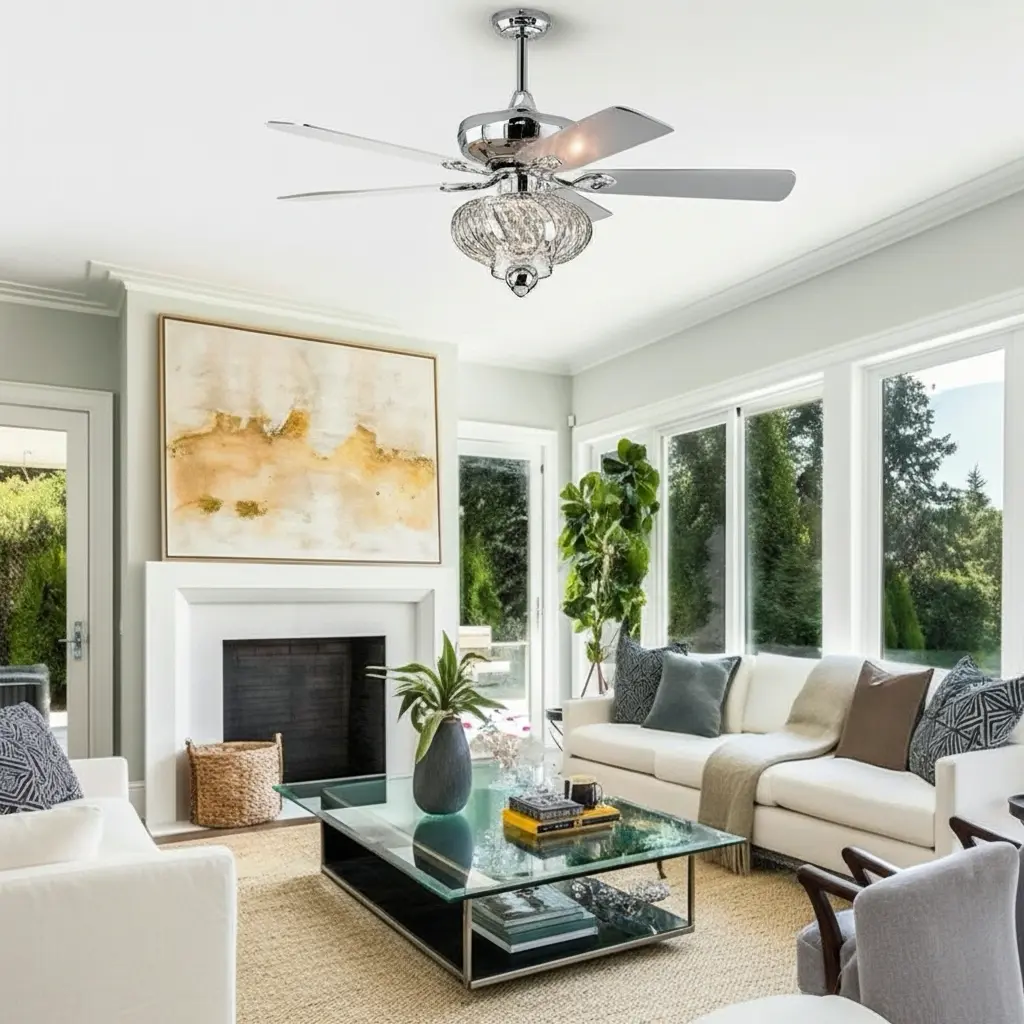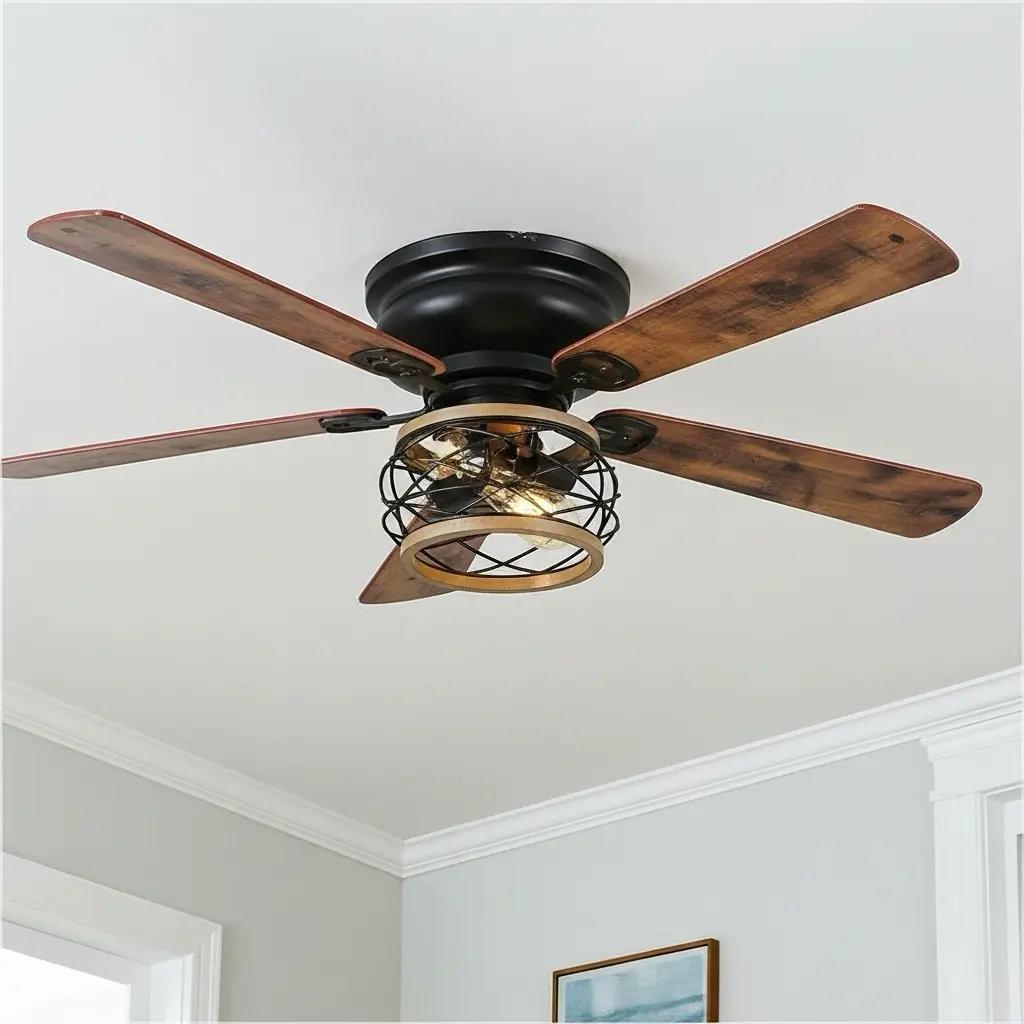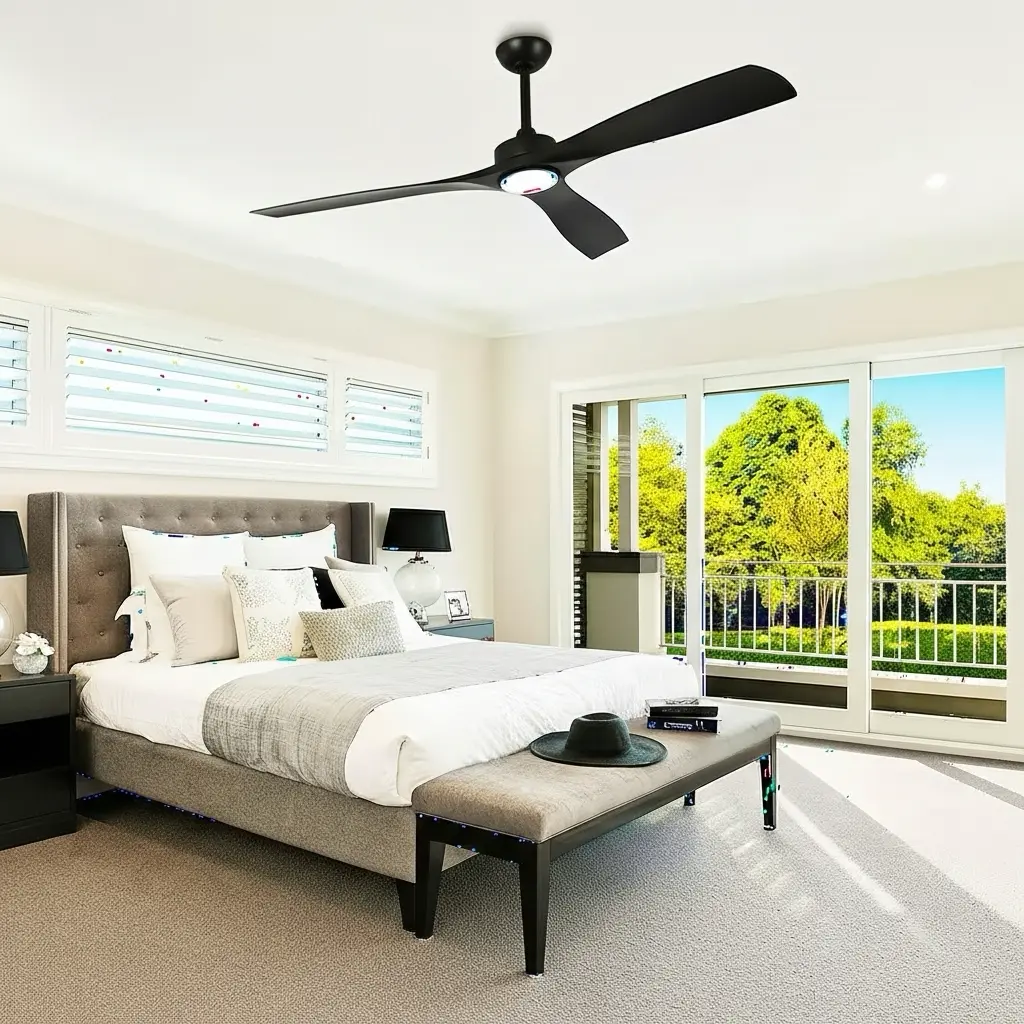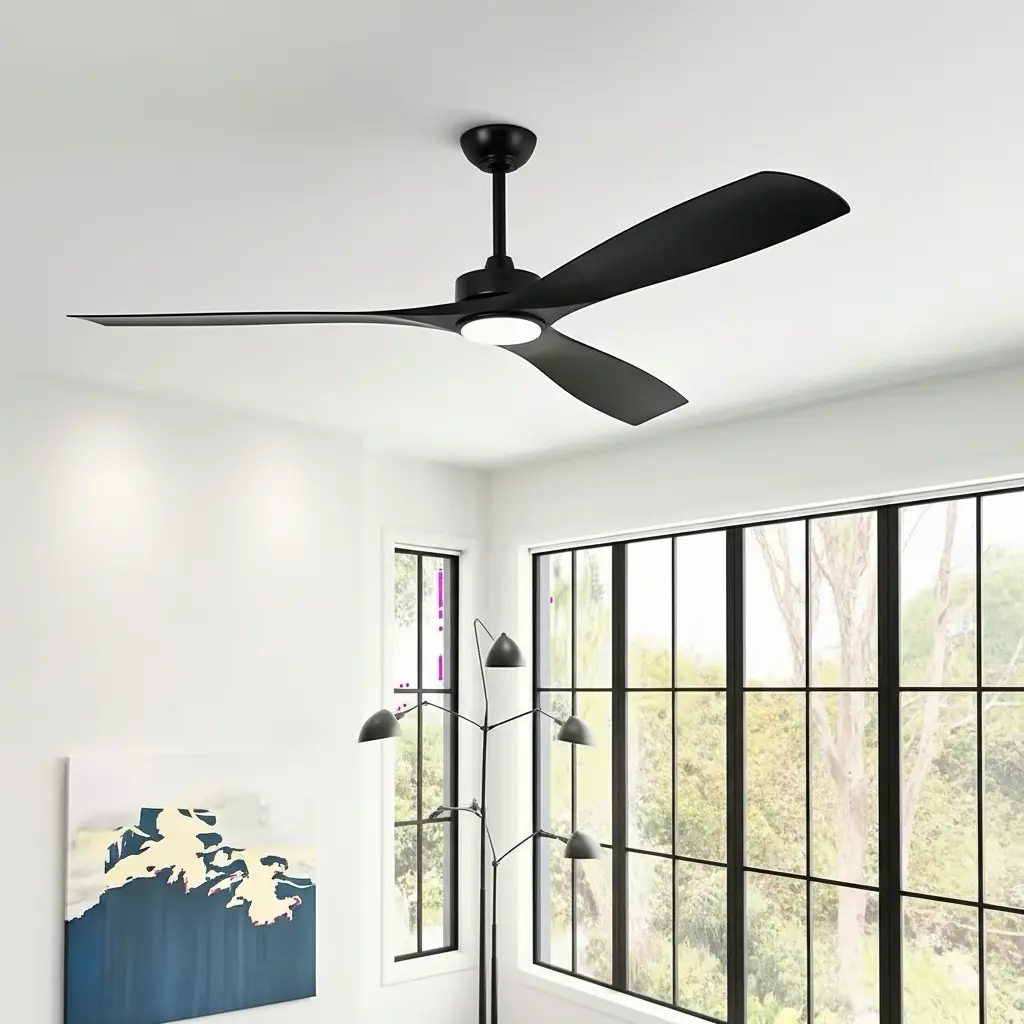Discover everything about Parrot Uncle ceiling fans from design innovation and energy efficiency to installation and model comparisons for U.S. homes and businesses.
Table of Contents

1) Introduction: Why Parrot Uncle Ceiling Fans Stand Out in 2025
Parrot Uncle ceiling fans have become a favorite across American households for their unique blend of artistry, quiet efficiency, and modern technology. Founded under the Minka Group umbrella, Parrot Uncle emphasizes contemporary and farmhouse-style aesthetics while keeping engineering performance on par with legacy manufacturers like Hampton Bay and Hunter Fan Company.
In 2025, the brand’s product lineup expands from low-profile flush-mount models for apartments to bold industrial-style fans for restaurants and lofts. Their dual-motor technology, dimmable LED integration, and brushless DC motors place them among the most energy-efficient ceiling fans available in the United States. Beyond comfort, these fixtures serve as design centerpieces that influence air quality, ambient lighting, and interior style.
With growing focus on sustainable HVAC solutions and the rising cost of air conditioning, homeowners and facility managers now view ceiling fans as part of a total climate-control strategy. This comprehensive guide explores Parrot Uncle’s latest models, engineering design, installation best practices, and comparative performance data — all tailored for the U.S. market.
2) Brand Background and Philosophy
Parrot Uncle entered the ceiling-fan market with a mission to merge craftsmanship + technology + value. The brand’s designs blend rustic wood grain, crystal-accented glass, and sleek matte finishes suited for American interiors from Texas ranch homes to New York City condos. Each collection prioritizes three engineering principles:
- Efficiency: Adoption of permanent-magnet DC motors that cut energy consumption by up to 70 % versus legacy AC models.
- Comfort: Optimized blade pitch (11°–16°) and aerodynamic airfoils for uniform air distribution across wide rooms.
- Style Integration: Designs spanning industrial metal, bohemian bamboo, farmhouse wood, and chandelier-style hybrids.
Today, Parrot Uncle competes directly with mid-premium players such as Hunter Industrial and Westinghouse Lighting, offering both residential and light-commercial solutions.

3) Design and Technology Overview
Parrot Uncle’s 2025 lineup introduces significant engineering upgrades to improve airflow performance and noise reduction.
Motor Technology
- AC Induction Motors: Found in entry-level units ($100 – $200); reliable but consume more energy.
- DC Brushless Motors: Used in premium collections; offer variable speed control, higher torque, and 60 % energy savings.
Lighting Integration
- Integrated LED modules (15 W – 24 W) with color-temperature tuning from 2700 K to 5000 K.
- CRI ≥ 90 for accurate color rendering in kitchens and living spaces.
- Dimming capability via remote or wall control down to 10 % brightness.
Material Selection
Most blades are crafted from ABS (polymer) or solid wood veneers. Motor housings use powder-coated steel or brushed aluminum. Outdoor-rated models feature sealed bearings and UV-resistant finishes tested to ASTM B117 salt-spray standards for coastal installations in Florida and California.
Figure 1 – Image Placeholder: “parrot-uncle-design-lineup.jpg” — collage of modern, farmhouse, and industrial models.
4) 2025 Model Comparison Table
The following table compares flagship Parrot Uncle collections by diameter, motor type, airflow (CFM), and efficiency. Values are averages from manufacturer data and Energy Star testing.
| Collection / Model | Diameter (in) | Motor Type | Airflow (CFM) | Power (W) | Efficiency (CFM/W) | Noise (dB) | Best For |
|---|---|---|---|---|---|---|---|
| Farmhouse Wood CF605 | 60 | DC | 6 000 | 35 | 171 | 42 | Living Room / Dining Area |
| Crystal Chandelier CF510 | 52 | AC | 4 500 | 55 | 81 | 48 | Bedroom / Decorative Spaces |
| Industrial Metal CF720 | 72 | DC | 9 800 | 60 | 163 | 46 | Restaurant / Loft / Office |
| Retractable Blade CF410 | 42 | DC | 3 500 | 30 | 117 | 43 | Small Bedrooms / Offices |
| Outdoor Damp CF820 | 84 | DC | 12 000 | 80 | 150 | 49 | Patio / Restaurant Terrace |
Figure 2 – Chart Placeholder: “parrot-uncle-efficiency-comparison.png” — bar graph comparing CFM/W ratings by model.
5) Mounting & Installation Guide (United States Standards)
Installing a Parrot Uncle ceiling fan follows standard U.S. National Electrical Code (NEC) guidelines. Always switch off the breaker before handling wiring and use UL-listed fan boxes rated for 70 lb or more.
Step 1 – Assess Ceiling Type
- Flat Ceiling: Use the standard mounting bracket and downrod (4–6 in typical).
- Sloped Ceiling: Choose an angled adapter kit for up to 25° pitch common in California and Arizona homes.
- Low Ceiling: Select a flush-mount (low-profile) model for 8 ft rooms to maintain 7 ft blade clearance.
Step 2 – Wiring Connections
- Black = hot (fan motor); Blue = hot (light kit); White = neutral; Green = ground.
- Connect using wire nuts rated for 12–14 AWG copper conductors.
- Test the LED module before securing the canopy.
Step 3 – Balancing and Testing
After installation, run the fan at medium speed to check for wobble. Use the included balancing weights if blade pitch variation exceeds 1⁄8 inch. Modern Parrot Uncle fans include self-calibration modes that adjust motor output for smooth operation.
Figure 3 – Image Placeholder: “ceiling-fan-installation-diagram.png” — step-by-step mounting diagram.
Safety Tip: If your existing fan uses a two-wire switch setup, consider an updated remote receiver to control light and speed separately without rewiring. See our guide on installing a Hampton Bay ceiling fan for similar steps and troubleshooting techniques.

6) Ceiling Height and Airflow Performance
Ceiling height directly affects comfort and airflow. Use the guidelines below to choose downrod length and speed settings.
<td style=”padding:8
| Ceiling Height (ft) | Recommended Downrod (in) | Ideal Fan Size (in) | Air Velocity (ft/s) | Suggested Model |
|---|---|---|---|---|
| 8 ft | Flush-mount | 42 – 48 | 1.8 | CF410 Retractable |
| 9–10 ft | 6 | 52 – 60 | 2.0 | CF605 Farmhouse Wood |
| 11–12 ft | 12 | 60 – 72 | 2.3 | CF720 Industrial Metal |
| 13 ft + |
7) Energy Efficiency and ROI
Parrot Uncle ceiling fans deliver measurable long-term savings when compared with older AC models. The table below estimates annual operating costs based on 8 hours of daily use at $0.14 / kWh — the 2025 U.S. average.
| Model | Motor Type | Power (W) | Annual kWh | Annual Cost (USD) | 5-Year Cost | Savings vs Legacy AC |
|---|---|---|---|---|---|---|
| CF605 Farmhouse Wood | DC | 35 | 102 | $14.30 | $71.50 | ≈ $80 saved |
| CF720 Industrial Metal | DC | 60 | 175 | $24.50 | $122.50 | ≈ $95 saved |
| CF510 Crystal Chandelier | AC | 55 | 160 | $22.40 | $112.00 | — |
DC-motor fans also allow thermostat adjustments upward by 2 °F in summer, translating to ≈ 4–6 % HVAC energy savings. Over five years, this can offset the fan’s entire purchase price.
Figure 5 – Chart Placeholder: “parrot-uncle-roi-chart.png” — five-year cost comparison AC vs DC motors.
8) Smart Features and Control Systems
Modern Parrot Uncle fans include intelligent controls for convenience and automation:
- Remote and Wall Controls: Standard 6-speed remotes with separate light buttons and programmable memory.
- Wi-Fi Integration: Alexa / Google Home compatible modules enable voice control and scheduling via Smart Life App.
- Reverse Mode: Winter mode circulates warm air upward to balance temperature gradients in tall rooms.
- Timer Functions: Auto-off 1-8 hours; ideal for bedrooms or offices.
- Multi-Fan Grouping: Sync multiple fans in restaurants or open-plan spaces.
Wi-Fi-enabled models consume < 1 W in standby mode and offer firmware updates for expanded smart-home features through 2026.

9) Troubleshooting and Maintenance
Routine care keeps your Parrot Uncle fan quiet and efficient for years. Follow these maintenance intervals aligned with UL 507 guidelines:
| Task | Frequency | Purpose |
|---|---|---|
| Dust blades & housing | Monthly | Prevents imbalance and motor strain. |
| Tighten mount & bracket screws | Semi-annually | Eliminates vibration and rattle noise. |
| Check LED module connectors | Annually | Ensures consistent light output and safety. |
| Lubricate bearings (if required) | Every 2 years | Maintains motor longevity on legacy AC models. |
Common issues include imbalance, humming, or remote pairing errors. Most can be resolved by resetting the remote, checking wire connections, or using the self-calibration mode in DC units.
10) Brand Comparison: Parrot Uncle vs Hampton Bay & Hunter Fans
While Hampton Bay remains a Home Depot exclusive and Hunter focuses on heritage designs, Parrot Uncle positions itself as a modern fusion brand — combining decorative appeal with performance metrics close to industrial-grade fans.
| Feature | Parrot Uncle | Hampton Bay | Hunter Fan Co. |
|---|---|---|---|
| Motor Type | DC (2025 series) | Mostly AC | AC / EC hybrid |
| Airflow Efficiency (CFM/W) | 150 – 180 | 100 – 120 | 130 – 150 |
| Average Noise Level | 42 – 48 dB | 48 – 52 dB | 44 – 50 dB |
| Smart Connectivity | Wi-Fi / App / Voice | Limited | Some models |
| Design Range | Contemporary to Rustic | Transitional | Classic / Heritage |
| Average Price Range (USD) | $120 – $350 | $80 – $250 | $150 – $400 |
In summary, Parrot Uncle delivers the best balance of modern design, quiet operation, and smart features for mid-range U.S. consumers.
11) Environmental Benefits & Sustainability
By integrating DC motors and recycled materials, Parrot Uncle fans help reduce CO₂ emissions by ≈ 3 tons per unit over a 10-year lifecycle compared to equivalent AC models. Blades and packaging use FSC-certified wood and recyclable cardboard. These specifications align with LEED v4.1 credits for Energy and Atmosphere and Materials & Resources.
12) Conclusion
Parrot Uncle ceiling fans represent a perfect marriage of design and engineering for the modern U.S. home. Their quiet DC motors, LED integration, and smart-control systems deliver high value at affordable prices. Whether you’re refreshing a living room in Texas or installing energy-efficient fans in a California restaurant, Parrot Uncle models offer long-term comfort and cost savings.
Ready to upgrade your home comfort?
Compare modern fans and installation tips in our guides on Hampton Bay Ceiling Fan Assembly and Large Industrial Ceiling Fans.

